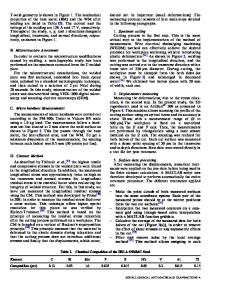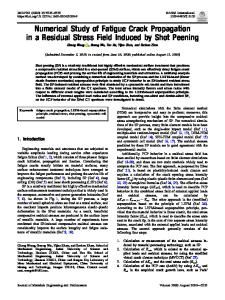The plastic zone and residual stress near a notch and a fatigue crack in HSLA steel
- PDF / 926,809 Bytes
- 9 Pages / 594 x 774 pts Page_size
- 113 Downloads / 359 Views
I.
INTRODUCTION
IT is
well known that the stress singularity at a notch or crack tip produces local deformation, and that the associated plastic upset results in residual stresses in and around this region. The maximum extent of the stresses and deformation is not directly ahead or above the crack. While there have been many theoretical and experimental studies of these phenomena, no study (of which we are aware) has examined experimentally both the stresses and the plastic deformation simultaneously, in two dimensions, around a notch or crack. This is the purpose of this study. Rice and Rosengren ~ and Hutchinson 2,3 have obtained theoretical solutions for the shape of the plastic zone, employing the Von Mises yield criterion, and allowing for work hardening. The former authors developed the solution for plane strain, with the shear stress, ~-, expressed in terms of the yield shear stress, ~'r, and the shear strains, 3, and %.: T
=
Ty
+
Ot(~//~/y) n
[1]
Here: r = [~r~j~ 0 2] 1;2, 3t = (2eoeo) 1;2, where ~" and 3, are stress and strain components, and repeated subscripts imply summation. Hutchinson's solution is for plane stress, with flow described with the form: =
-
-
try
+ ct
\ ~y/
[2]
In this case the work hardening exponent, N, is the inverse o f n in Eq. [1]. Both solutions assume that the stress singulaxity near the notch or crack can be approximated by the first term in an asymptotic series expansion. Plastic zones calculated from these theories are illustrated in Figure 1. For plane strain, the maximum extent of the zone moves closer to the crack plane as work hardening increases, assuming a "butterfly" shape. The zone size decreases with increasing work hardening exponent, for both plane stress and plane strain. While these calculations are applicable to monotonic loading, their application to fatigue requires some caution, W.H. SCHLOSBERG, formerly Research Assistant, Department of Materials Science and Engineering, The Technological Institute, Northwestern University, Evanston, IL, is now with Bendix Corporation, Kansas City, MO 64141. J.B. COHEN is Frank C. Engelhart Professor of Materials Science and Engineering, The Technological Institute, Northwestern University, Evanston, IL 60201. Manuscript submitted December 21, 1981. METALLURGICAL TRANSACTIONS A
because both authors assume the stress is proportional to strain. Also, Rice 4 has indicated that there may be two plastic zones ahead of a fatigue crack, the outer one due to tensile loading, and the inner one due to reverse loading, and approximately one quarter the size of the outer one. Experimental studies of the plastic zone are summarized in Table I. Except for the last entry, z~ the delineation of the zone has been rather arbitrary, and (other than the first entry) the agreement with theory poor. Liaw et a121 have noted that agreement is good if the stress for zero hysteresis in incremental strain controlled fatigue is employed in the calculation, rather than the cyclic yield stress. (This stress is much less than the cyclic yi
Data Loading...











